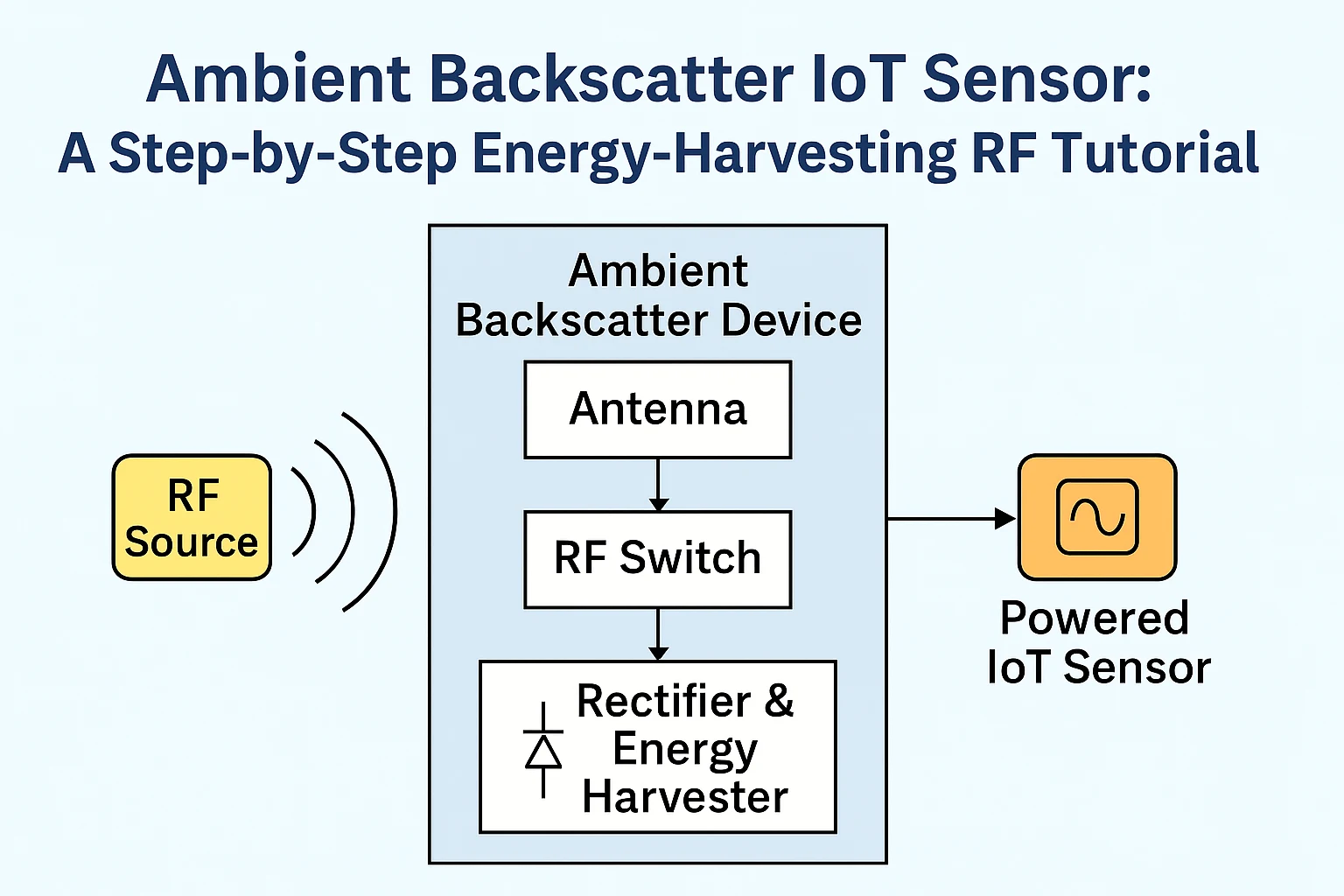Introduction
With the rise of the Internet of Things (IoT), the demand for power-efficient and maintenance-free sensors has surged. Traditional wireless sensors depend on batteries, which limit device lifespan and introduce environmental concerns. An innovative solution to this problem is ambient backscatter communication, a technique that enables devices to transmit data by reflecting existing ambient radio frequency (RF) signals—without needing a battery.
This tutorial introduces ambient backscatter technology, explains how it works, and guides you through building a basic ambient backscatter IoT sensor. We’ll explore how ambient energy harvesting works, the components required, implementation steps, and real-world applications.
What is Ambient Backscatter Communication?
Ambient backscatter communication is a technique in which devices modulate and reflect ambient RF signals (such as TV, Wi-Fi, or cellular) to communicate data. Instead of generating new signals, these devices backscatter existing RF waves using low-power circuits.
Key Characteristics:
- Battery-less communication
- Utilizes existing ambient RF sources
- Ultra-low power (<10 microwatts)
- Ideal for passive IoT networks
How Does It Work?
At the core of ambient backscatter is a modulating load that changes the impedance of an antenna to reflect or absorb ambient RF waves. This impedance variation represents binary data (1s and 0s).
Block Diagram:
[Ambient RF Source (Wi-Fi/TV/Cellular)]
↓
[Backscatter Tag / Sensor Node]
┌──────────────────────────────┐
│ • Antenna │
│ • Matching Network │
│ • RF Switch (Modulation) │
│ • Microcontroller / Sensor │
└──────────────────────────────┘
↓
[Receiver (SDR/Gateway/Phone)]
- Ambient RF Source: Provides constant RF energy.
- Backscatter Tag: Modulates and reflects RF signal by toggling load impedance.
- Receiver: Detects and decodes the modulated signal.
Advantages of Ambient Backscatter
| Feature | Benefit |
|---|---|
| Batteryless | No need for charging or replacement |
| Low-cost Hardware | Uses minimal circuit components |
| Scalable | Suitable for large-scale IoT deployment |
| Eco-Friendly | No toxic waste from battery disposal |
Components Required
| Component | Description |
|---|---|
| Antenna (Dipole/PCB) | Receives and reflects RF signals |
| RF Switch (Analog) | Switches load impedance for modulation |
| Load Resistors | Used for load variation |
| Microcontroller (Optional) | For controlling switching & sensing |
| Ambient RF Source | Wi-Fi Router / TV Tower / LTE Base Station |
| Receiver (SDR/Phone) | Software-defined radio or backscatter reader |
Optional: Use development platforms like TI Launchpad, ESP32, or Raspberry Pi Pico for control logic.
Step-by-Step Tutorial: Build a Basic Ambient Backscatter Sensor
Step 1: Build the Antenna and Matching Network
- Use a standard 2.4 GHz dipole or PCB antenna
- Add impedance matching network using capacitors/inductors (if needed)
Step 2: Design Modulation Circuit
- Connect RF switch (e.g., ADG902, BSS84) in parallel with load resistor
- Control the switch using a GPIO pin from a microcontroller or sensor logic
Step 3: Configure Data Modulation
- Binary 1: RF switch closed, reflects signal
- Binary 0: RF switch open, absorbs signal
- Toggle GPIO to send data like temperature/humidity
Step 4: Deploy Ambient RF Source
- Ensure Wi-Fi router or LTE signal is present nearby
Step 5: Capture Reflected Signal
- Use SDR dongle (e.g., RTL-SDR) connected to a laptop
- Use software like GNU Radio or SDR# to analyze signals
Applications
- Smart agriculture (soil sensors without batteries)
- Supply chain and logistics (RFID-like asset tracking)
- Smart cities (environmental monitoring)
- Medical implants (batteryless health monitors)
- Industrial IoT (equipment vibration monitoring)
Challenges and Limitations
| Limitation | Explanation |
|---|---|
| Short Range | Typically 1–5 meters depending on RF power |
| Signal Interference | Ambient sources may fluctuate |
| Data Rate | Limited to kbps range |
| Receiver Complexity | Requires sensitive SDR setups |
Future of Ambient Backscatter
Ambient backscatter is at the frontier of ultra-low-power wireless technology. Research is ongoing into:
- MIMO backscatter for extended range
- Machine learning for signal decoding
- Integration with 6G/edge networks
- Hybrid backscatter + BLE systems
Conclusion
Ambient backscatter offers a revolutionary way to deploy wireless IoT systems without the burden of batteries or frequent maintenance. With basic components and SDR tools, engineers, students, and hobbyists can experiment with battery less communication and explore new frontiers in energy-efficient connectivity.
Start today by building your own ambient backscatter sensor—and lead the way into a battery-free IoT future.
